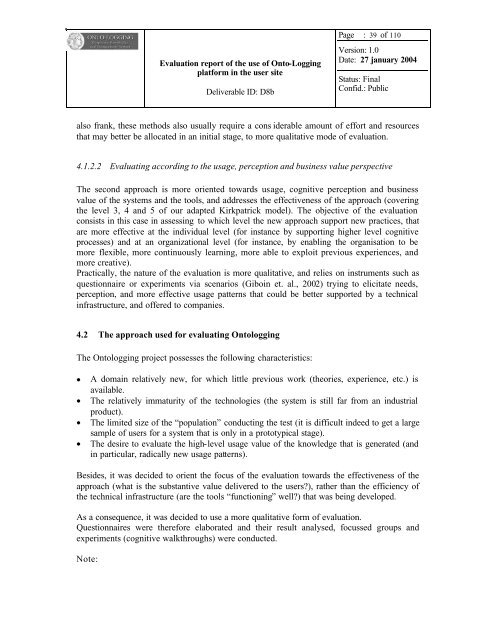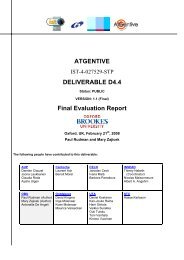pdf 820Kb - INSEAD CALT
pdf 820Kb - INSEAD CALT
pdf 820Kb - INSEAD CALT
Create successful ePaper yourself
Turn your PDF publications into a flip-book with our unique Google optimized e-Paper software.
Evaluation report of the use of Onto-Logging<br />
platform in the user site<br />
Deliverable ID: D8b<br />
Page : 39 of 110<br />
Version: 1.0<br />
Date: 27 january 2004<br />
Status: Final<br />
Confid.: Public<br />
also frank, these methods also usually require a cons iderable amount of effort and resources<br />
that may better be allocated in an initial stage, to more qualitative mode of evaluation.<br />
4.1.2.2 Evaluating according to the usage, perception and business value perspective<br />
The second approach is more oriented towards usage, cognitive perception and business<br />
value of the systems and the tools, and addresses the effectiveness of the approach (covering<br />
the level 3, 4 and 5 of our adapted Kirkpatrick model). The objective of the evaluation<br />
consists in this case in assessing to which level the new approach support new practices, that<br />
are more effective at the individual level (for instance by supporting higher level cognitive<br />
processes) and at an organizational level (for instance, by enabling the organisation to be<br />
more flexible, more continuously learning, more able to exploit previous experiences, and<br />
more creative).<br />
Practically, the nature of the evaluation is more qualitative, and relies on instruments such as<br />
questionnaire or experiments via scenarios (Giboin et. al., 2002) trying to elicitate needs,<br />
perception, and more effective usage patterns that could be better supported by a technical<br />
infrastructure, and offered to companies.<br />
4.2 The approach used for evaluating Ontologging<br />
The Ontologging project possesses the following characteristics:<br />
• A domain relatively new, for which little previous work (theories, experience, etc.) is<br />
available.<br />
• The relatively immaturity of the technologies (the system is still far from an industrial<br />
product).<br />
• The limited size of the “population” conducting the test (it is difficult indeed to get a large<br />
sample of users for a system that is only in a prototypical stage).<br />
• The desire to evaluate the high-level usage value of the knowledge that is generated (and<br />
in particular, radically new usage patterns).<br />
Besides, it was decided to orient the focus of the evaluation towards the effectiveness of the<br />
approach (what is the substantive value delivered to the users?), rather than the efficiency of<br />
the technical infrastructure (are the tools “functioning” well?) that was being developed.<br />
As a consequence, it was decided to use a more qualitative form of evaluation.<br />
Questionnaires were therefore elaborated and their result analysed, focussed groups and<br />
experiments (cognitive walkthroughs) were conducted.<br />
Note:
















